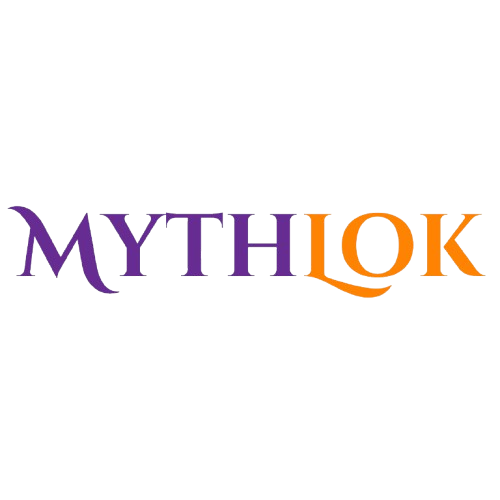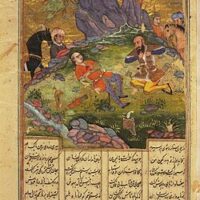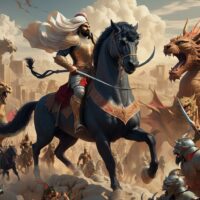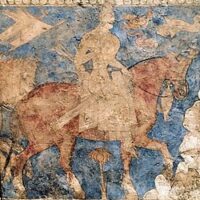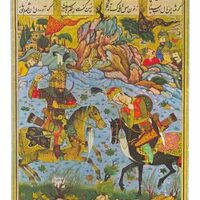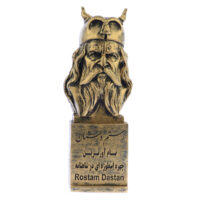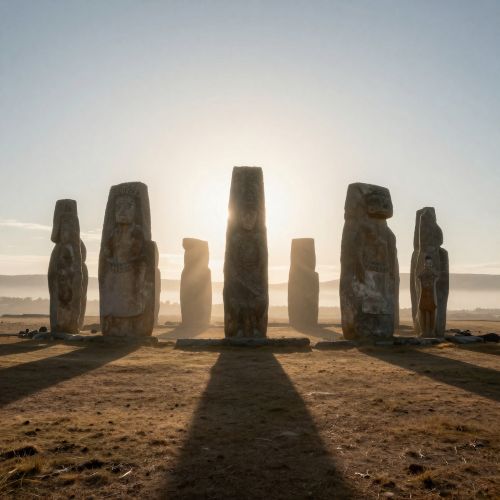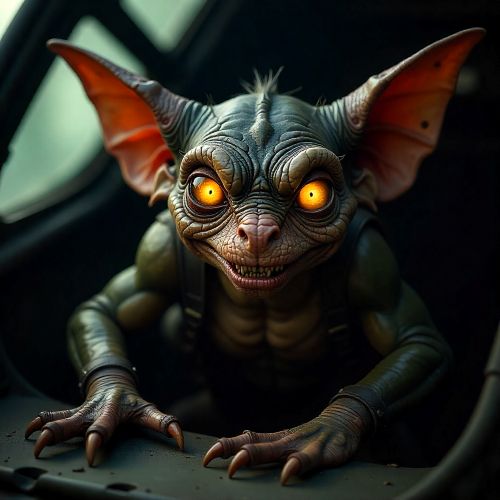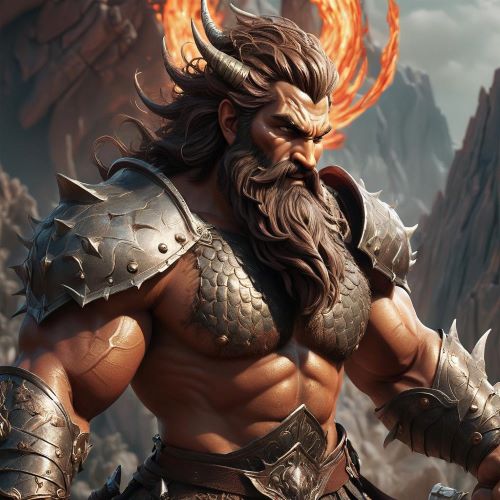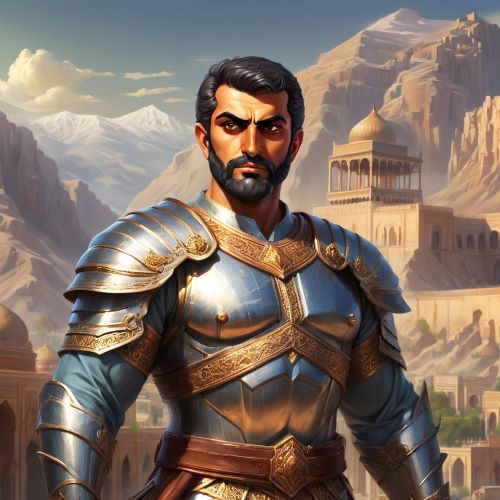Rostum : The Hero of Heroes
Listen
At a glance
| Description | |
|---|---|
| Origin | Iranian Mythology |
| Classification | Mortals |
| Family Members | Zal (Father), Rudaba (Mother), Sohrab (Son), Banu Goshasp (Daughter) |
| Region | Iran |
| Associated With | Bravery, Valour, War |
Rostum
Introduction
Rostum, the legendary Persian hero, stands as one of the most revered characters in the Shahnameh, Ferdowsi’s monumental epic that shaped Persian cultural identity. He is the embodiment of courage, honor, and national pride, often compared to mythological titans like Hercules. Rostum’s tales not only reflect heroic valor but also capture the deep emotional complexities of fate, loyalty, and personal sacrifice. His origin, development, and legacy remain a cornerstone of Iranian mythology, symbolizing the enduring fight against oppression and injustice.
Physical Traits
Although ancient texts like the Shahnameh don’t always offer specific physical descriptions, Rostum’s stature is inferred through his legendary exploits. He is consistently portrayed as a giant among men—his strength so great that he could wrestle lions and lift boulders with ease. His battle attire includes the mythical armor Babr-e Bayan, said to be impenetrable and made from panther skin. Rostum’s primary weapons include a colossal mace, a lasso, and a mighty sword, while his trusty steed, Rakhsh, is renowned for its ferocity and intelligence. Together, the duo was unstoppable on the battlefield, representing the ideal synergy between man and beast in Persian warrior culture.
Family
Rostum’s lineage is steeped in myth and nobility. His father, Zāl, was an albino warrior raised by the divine bird Simurgh, making Rostum a semi-divine figure with supernatural favor. His mother, Rudaba, a Kabulian princess, faced life-threatening labor due to Rostum’s enormous size at birth. The Simurgh intervened, guiding Zāl through a miraculous birth that saved both mother and child—one of the earliest mythic accounts of a caesarean-like procedure.
Rostum’s family narrative is both heroic and tragic. His son, Sohrab, born of a secret union, unknowingly fought his father in battle and was killed before either knew their true relationship. This poignant episode, “Rostum and Sohrab,” remains a literary high point in Persian literature. His daughter, Banu Goshasp, inherited her father’s warrior spirit, and his brother Faramarz carried on the family’s heroic tradition. However, betrayal came from within—his half-brother Shaghad plotted his death out of envy, leading to Rostum’s ultimate downfall.
Other names
Throughout Persian texts and oral traditions, Rostum is known by several titles that reinforce his legendary status. “Rustam” and “Rustem” are popular alternate spellings used in various regions and translations. The title “Tahmatan,” meaning “broad-chested” or “herculean,” emphasizes his brute strength. He is also referred to as “Pilten,” or “elephant-bodied,” further alluding to his physical dominance. Another honorific, “Jahan Pahlavan,” translates to “World Champion,” underscoring his role as the greatest paladin in Iranian lore. Each of these names encapsulates a facet of his character—might, honor, and national symbolism.
Powers and Abilities
Rostum’s prowess in battle is the stuff of legends. His strength surpassed that of ordinary men, enabling him to defeat demons, dragons, and rival champions. A master of multiple forms of combat, he excelled in archery, swordplay, wrestling, and mounted warfare. His intellect matched his physical abilities—many of his victories were as much about clever strategy as brute force.
One of the most famous stories of Rostum’s might is Haft Khan, or “The Seven Labors of Rostum.” This epic journey saw him battle wild beasts, outwit sorcerers, and confront the terrifying White Demon. His resilience and divine favor allowed him to succeed where others would have perished.
The mystical bird Simurgh played a recurring role in empowering Rostum. From his birth to his healing after critical wounds, Simurgh’s guidance and magical feathers helped him recover and succeed in seemingly impossible situations. This celestial alliance not only boosted his physical might but also deepened the spiritual aura around his legend.
Modern Day Influence
Rostum’s legacy has transcended time, remaining a vital part of Iranian cultural identity and continuing to shape artistic and literary traditions. His epic, especially the heartbreaking tale of his son Sohrab, is still taught in schools, performed on stage, and referenced in poetry and visual storytelling. The enduring emotional power of his narrative, centered on honor, fate, and tragedy, resonates with universal human experiences, making Rostum a timeless figure not just in Iran, but in many cultures influenced by Persian literature.
Internationally, Rostum’s story has found new life through various artistic expressions. In 1853, Matthew Arnold’s Sohrab and Rustum introduced English-speaking audiences to the Persian heroic tradition. His legend inspired operas and plays like Rustam and Zohrab (1910) in Azerbaijani and Rustom O Sohrab (1929) in Urdu, reflecting its cultural impact across Central and South Asia. Film and television adaptations such as Rostam va Sohrab (1957) and Rustom Sohrab (1963) further explored his emotional depth, while modern formats like the animated film Battle of the Kings (2013) and the English musical piece Sooge Sohrab (2014) have reintroduced him to younger, global audiences.
Rostum also appears in visual and digital arts, often portrayed in innovative ways that blend tradition with modernity. From miniature-style paintings infused with contemporary themes to digital comic series like Rostam in Wonderland, his character remains relevant and inspiring. Even video games and pop culture occasionally feature Rostum-inspired figures—mighty, noble, and complex—keeping his legend alive in modern narratives. Among diaspora communities, his story continues to serve as a powerful symbol of resilience, moral struggle, and Persian heritage.
Related Images
Source
Ferdowsi, A. (2006). Shahnameh: The Persian Book of Kings (D. Davis, Trans.). Penguin Classics.
Davis, D. (2007). Rostam: Tales of Love and War from Persia’s Book of Kings. Mage Publishers.
Grenet, F. (2015). The Rustam Legend and Its Historical Echoes. Iranica Antiqua, 50, 1–20.
Ferdowsi. (n.d.). Tragedy of Rostam and Sohrab: First Example Introducing the …. Retrieved from https://pmc.ncbi.nlm.nih.gov/articles/PMC4411917/
Wikipedia. (2005, March 5). Rostam – Wikipedia. Retrieved from https://en.wikipedia.org/wiki/Rostam
Gale. (n.d.). Rostam as a Pre-Historic Iranian Hero or the Shi’itic … – Gale. Retrieved from https://go.gale.com/ps/i.do?id=GALE%7CA606483664&sid=googleScholar&v=2.1&it=r&linkaccess=abs&issn=19498519&p=LitRC&sw=w
World History Encyclopedia. (2020, May 22). Shahnameh – World History Encyclopedia. Retrieved from https://www.worldhistory.org/shahnameh/
Britannica. (n.d.). Shāh-nāmeh | Persian Epic, Epic Poem, Epic Poetry | Britannica. Retrieved from https://www.britannica.com/topic/Shah-nameh
The Ancient History Bulletin. (n.d.) × es-Diff-1.1-2024-.pdf – The Ancient History Bulletin |*. Retrieved from https://ancienthistorybulletin.org/wp-content/uploads/2024/03/Res-Diff-1.1-2024-.pdf
Harvard Extension School. (n.d.). 2023-2024 Extension Course Archive. Retrieved from https://extension.harvard.edu/2023-2024-extension-course-archive/
Frequently Asked Questions
What is lorem Ipsum?
I am text block. Click edit button to change this text. Lorem ipsum dolor sit amet, consectetur adipiscing elit. Ut elit tellus, luctus nec ullamcorper mattis, pulvinar dapibus leo.
What is lorem Ipsum?
I am text block. Click edit button to change this text. Lorem ipsum dolor sit amet, consectetur adipiscing elit. Ut elit tellus, luctus nec ullamcorper mattis, pulvinar dapibus leo.
What is lorem Ipsum?
I am text block. Click edit button to change this text. Lorem ipsum dolor sit amet, consectetur adipiscing elit. Ut elit tellus, luctus nec ullamcorper mattis, pulvinar dapibus leo.
What is lorem Ipsum?
I am text block. Click edit button to change this text. Lorem ipsum dolor sit amet, consectetur adipiscing elit. Ut elit tellus, luctus nec ullamcorper mattis, pulvinar dapibus leo.
What is lorem Ipsum?
I am text block. Click edit button to change this text. Lorem ipsum dolor sit amet, consectetur adipiscing elit. Ut elit tellus, luctus nec ullamcorper mattis, pulvinar dapibus leo.

